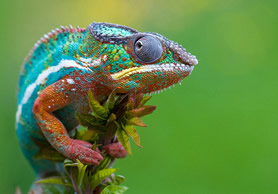How to Take Care of a Chameleon – The Basics
 Chameleons make great pets for those willing to properly care for them. Properly caring for a chameleon requires much more than simply tossing them into an aquarium with plants and then leaving them. Chameleons make great pets for those willing to properly care for them. Properly caring for a chameleon requires much more than simply tossing them into an aquarium with plants and then leaving them.
Chameleons require a lot of devotion if it is to thrive. It depends on the perfect environment to maintain its health. Unlike most other pets, a chameleon is completely dependant on its environment. Here are the basics of caring for a chameleon.
Purchasing your chameleon. The easiest species of chameleon to care for are either Veiled, Panther, or Jackson chameleons. The optimal age to buy a chameleon is anywhere from 3 to 8 weeks old. Pay attention to the chameleon being fed before buying it since most health issues are seen through its eating habits. Before you head off to the pet shop, make sure you know the 11 factors you need to be aware of when buying a chameleon, along with how to spot the 12 signs that indicate a chameleon is not healthy.
Set up a habitat. Make sure that you have a large enough habitat for the chameleon to thrive. A chameleon will grow at a fast pace so you want it to be large enough for an adult chameleon. A habitat must have green, thriving plants, a basking lamp, a cooldown zone, and enough twigs to allow for easy climbing. Just be sure that no reachable area is within a foot of the lamp. Chameleons do not seem to care if they get burned or not and they will climb as close to the heat source as possible.
Feeding your chameleon is much more complicated than you may be used to. Crickets are their favorite food but chameleons require a large variety of insects to keep them from getting bored with their food. If your local pet shop does not sell a wide variety of insects, then you can find them online or just catch them yourself.
While reading online, you might come across the term "gut loaded." This simply means that you feed the insects a nutritious diet before feeding them to your chameleon. You should also dust some of the insects with calcium dust since most chameleons will suffer from calcium deficiency.
Chameleons love wax worms, flies, moths, meal worms, and grasshoppers. As explained in the "Chameleon Care Guide" – a varied diet is extremely important for a healthy chameleon.
Provide the chameleon with water. There are a lot of ways to accomplish this. If you notice that your chameleon is licking leaves or other shiny objects inside of the habitat, that means he is thirsty. Mist the leaves and the side of the aquarium with water to give him some water to lick. Some people even train their chameleons to drink from a bottle or dropper. However, misting is the best practice.
Ensure that your chameleon's habitat is an optimal temperature. The first thing you need to do is buy a thermometer to place inside of the habitat. It's always better to know the temperature rather than guess.
Once you can verify the temperature inside of the habitat, you can then place a lamp for basking and warming the aquarium. This basking zone should be around 90 degrees (33 C). This lamp should be left on for 12 hours to simulate daylight. Then it needs to be shut off to simulate night and offer a cool down time.
Ensure the proper humidity level by purchasing a hygrometer. If it falls below 50%, then you will need to increase misting. However, if it rises above 80% then you will need to reduce it. Optimum humidity is anywhere between 60% and 70%.
Invest in a drip system that can be set using a timer.
Use a spray bottle to mist the enclosure. Aim for the leaves since chameleons love to lick up the water. You can even buy a misting system but they are complicated to install.
The enclosure should be cleaned once a week. Remove all dead insects, plants, and any standing water. Create a soapy solution using a tiny bit of dish soap and clean everything. You might want to have a standby habitat so that you can move your chameleon during the cleaning process. Otherwise, you will stress out the little guy!
It's important that you thoroughly rinse all of the soap out of the aquarium before putting your chameleon back inside.
Chameleons are solitary creatures. They do not like to be around other animals, including chameleons. Placing two chameleons into the same habitat is a bad idea since they will both stress over the presence of the other. However, an often overlooked problem is when a chameleon can see its own reflection. It will believe its reflection to be another chameleon. Remove anything that might cast its reflection and make sure your home is 'chameleon-proof'!
Finally, if you own a female chameleon then you need to constantly watch for signs of her wanting to lay eggs. Yes, female chameleons will lay eggs regardless of whether they are fertilized or not. When a female is looking to lay eggs, she will wonder around the bottom of the aquarium and try to get out. She needs a place to bury those eggs.
Please make sure you have enough knowledge of how to care for a chameleon before you get one. Most chameleons die off in the first week of purchase, and often this is down to the owner to knowing the basic facts of chameleon care. For a comprehensive all-you-need-to-know manual on chameleon care, check out "Chameleon Care Guide – Keeping & Breeding Healthy Chameleons Made Easy!"

|